Thirty years ago, a handful of tenacious physicists put up a $5 million storage ring on a parking lot at SLAC. Shawna Williams reflects on its glorious past and its promising future.
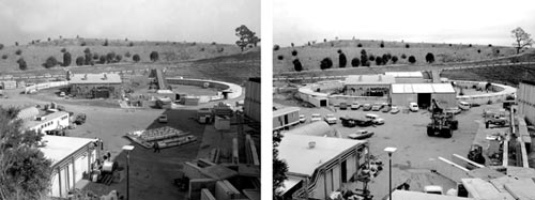
In 1972, only 20 months after its construction had finally been agreed, the SPEAR electron-positron collider went into service on a parking lot at SLAC, and by spring 1973 had started to deliver its first physics data. From its humble beginnings, the machine went on to revolutionize particle physics, with two of the physicists who used it receiving Nobel prizes. It also pioneered the use of synchrotron radiation in a variety of fields in scientific research. In March this year, technicians began upgrading SPEAR, and now only the housing and control room remain of the original machine. Burt Richter, whose dogged determination led to the machine’s existence, likens SPEAR to a character in Alice in Wonderland. “It’s like the Cheshire cat,” he says, “there’s nothing left but its smile.”
SPEAR was elusive from the start. “The initial question was, how do you build such a machine?” says Martin Perl, who like Richter was to receive the Nobel prize for his work on the machine. “The idea of building an electron-positron collider was not in the mainstream back then.” Richter and others at Stanford first proposed building the Stanford Positron-Electron Asymmetric Rings (SPEAR) in 1964, at a time when hitting a fixed target with a beam was the standard way of doing high-energy physics. From 1964 to 1970, annual requests for funding to the US Atomic Energy Commission (AEC) were repeatedly rejected, even though Richter slashed the application from $20 million to $5 million. During one of the revisions to the proposal, the two planned rings became one and SPEAR was no longer asymmetric; but the name stayed. Finally, in 1970, SLAC’s director, W K H “Pief” Panofsky, spoke to the AEC’s comptroller, John Abbadessa, who said that if SPEAR was an experiment with no permanent buildings, it could be built out of SLAC’s normal operating budget.
Richter’s team had hoped to build the collider in two years; they finished four months ahead of schedule. “It certainly was the most fun I’d ever had building a machine,” says John Rees, one of the accelerator physicists involved. Moreover, the funding delay had actually worked to SLAC’s advantage in some ways, since they now had other colliding-beam storage rings to look to. “By that time, we’d learned enough from other people to be able to build the best machine,” explains Perl.
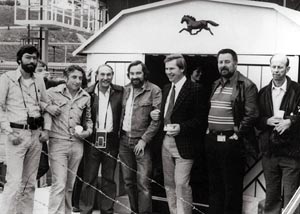
SPEAR had another advantage: a new kind of detector, called the SLAC-LBL Magnetic Detector or Mark I, which uniformly surrounded the interaction point. The design “flew in the face of conventional wisdom about how to build detectors for colliders,” says Marty Breidenbach of SLAC, who was a post-doc at the time.
SPEAR had a second interaction point devoted to more specialized experiments than the Mark I. “We wanted to give more independent physicists an opportunity to use this new and unique facility, and they all worked,” recalls Panofsky. “But they were basically less productive than the approach of having one detector looking at everything that came from the collisions and then later, whilst offline, unpickling everything to sort out what was important.” Since then, says Panofsky, “colliding machines all over the world have followed the pattern set by the general-purpose, solenoidal-type magnetic detectors, which were the Mark I and Mark II.”
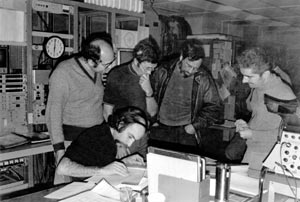
From the beginning, some Stanford faculty members, including Sebastian Doniach, William Spicer and Arthur Bienenstock, realized SPEAR’s potential to produce useful synchrotron radiation, so they asked Panofsky and Richter to devise a way to allow X-rays out of SPEAR. The X-ray synchrotron radiation emitted by the circulating beams in the machine was much higher in intensity than anything available for structural analysis in many areas of research, from semiconductor materials to protein molecules. So Richter’s team attached an extra vacuum chamber to SPEAR and made provision for a hole in the shielding wall for the beamline. This was the start of the Stanford Synchrotron Radiation Project (SSRP).
The revolution begins
In the spring of 1973, SPEAR began to gather high-energy physics data. By the next year, the machine was measuring very erratic values of R, the ratio of hadron production to lepton production. These were the first signs of a new particle, which Richter’s team called the “psi” (Ψ). “Nobody dreamed that there was any state, particle, that was as narrow in width as the Ψ turned out to be,” says Richter. “So the first question was what the hell was wrong with the apparatus, is there something wrong with the computers, is there something wrong with the data taking?”
No-one could find any such errors, and some researchers on the Mark I collaboration pushed to rescan the region. But by this time SPEAR had been upgraded and Bob Hofstadter, who was running an experiment at SPEAR’s other detector, wanted to move on to higher energies. Finally Richter decided to go ahead with rechecking the anomalous results, but only for one weekend in November 1974. At about 3.1 GeV the group began to see impossibly high particle production. “It didn’t take very long before the control room started to fill up with people, because the yield of these particles kept going up and up and up as we made tiny little changes in the energy of the machine,” recalls Richter. Word travelled fast. “We started getting calls from all over the country,” says Breidenbach. “There was no need to check anything – the signal was beyond any statistics. It was there. No-one had ever seen anything like it.”
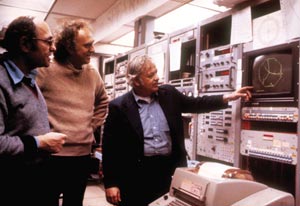
One of the first physicists outside SLAC to learn of the discovery was Sam Ting of Brookhaven National Laboratory, who happened to be visiting SLAC the day after the psi’s discovery. Ting’s lab, it turned out, had detected the same particle using a different method, but hadn’t yet confirmed it to Ting’s satisfaction. He called it the J. Whatever the name, Ting’s results meant that the new particle had been observed in two experiments and the table of particles had to be revised. Around this time, Panofsky went to the AEC to see Abbadessa. “I said I wanted to announce the discovery of an unauthorized particle on an unauthorized machine,” Panofsky recalls. “He liked that.”
SPEAR meanwhile continued to yield breakthroughs. “We had a fantastic time for a year or so – we were writing close to a paper per week,” Breidenbach remembers. Subsequent experiments revealed that the J/Ψ was the bound state of a new quark – charm – with its antiquark. This was the first discovery of a new quark since Murray Gell-Mann and George Zweig had first put forward the ideas of the quark model in 1964, and it brought the number of known quarks to four. It also confirmed the theoretical ideas of Sheldon Glashow, John Iliopoulos and Luciano Maiani, which grouped four quarks in two “generations”. This breakthrough came to be known as the November Revolution. “And then the next year Martin Perl changed the rules of the game again,” Richter says.
The tau was discovered soon after the J/Ψ and with the same detector, but there the comparison ended. Perl wanted to test his idea that electrons and muons were just the beginning of a series of particles. Rather than designing an experiment to find the next-heaviest particle in the series, he teased out the tau from data recorded on Mark I during more general runs. The tau particle turned out to be part of a third generation of matter, which involves six quarks rather than the four known at the time. Richter and Ting won the Nobel prize in 1976, reflecting the physics community’s swift acceptance of the J/Ψ. The third generation turned out to be harder to verify than the second, but Perl was finally rewarded with his Nobel prize in 1995.
Synchrotron radiation for all
Even though it began as a parasitic operation, synchrotron radiation represented an unparalleled opportunity. Use of the SSRP quickly expanded from materials science to chemistry to structural biology. “No-one had ever had effective access to a broad spectrum ranging from the deep ultraviolet into the hard X-rays from a multi-GeV storage ring for these kinds of experiments,” says Keith Hodgson, now associate director of the SSRP’s successor, the Stanford Synchrotron Radiation Laboratory (a division of SLAC). “This really was one of the first of the modern synchrotron radiation research user facilities.” The National Science Foundation approved the SSRP grant proposal early in 1973, and soon a pilot beam was up and running. The SSRP team began accepting proposals for experiments, and recorded its first useable data in summer 1974.
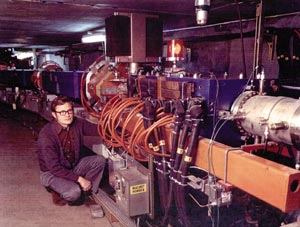
The November Revolution later that year was a disaster for SSRP’s users, because after that the high-energy physicists began doing experiments in the 3.1 GeV region or 1.55 GeV per beam, which was nowhere near the 2.4 GeV per beam that SPEAR was capable of. “We had what we called the X-ray drought,” says Herman Winick, SSRP’s first full-time employee and deputy director. In 1978, the group solved this problem by installing “wiggler” magnets in the storage ring, the first time such magnets were used in synchrotron radiation experiments. Wiggler magnets cause particles to wind sharply back and forth as they travel through a storage ring, emitting focused synchrotron radiation with every turn. Not only did the wigglers enhance synchrotron emission and extend it to higher energies, but they also boosted luminosity for the high-energy physicists.
By the decade’s end, synchrotron radiation research was gaining the upper hand at SPEAR, with 50% of the machine experiment time devoted to X-ray research. In 1980 the Stanford Synchrotron Radiation Laboratory (SSRL), as the SSRP was by then known, received a National Institutes of Health grant to make its X-rays more accessible to structural biologists. Dramatic growth in demand and productivity was also seen in materials sciences and other areas, especially after SPEAR operation was transferred to the US Department of Energy (DOE) in 1982. In the following years, under the stewardship of the DOE Office of Basic Energy Sciences, the SSRL has grown to serve about 1800 users, who mount over 1000 individual experiments each year from a range of disciplines. In 1997 particle-physics experiments on SPEAR ended and the ring became devoted solely to synchrotron radiation research.
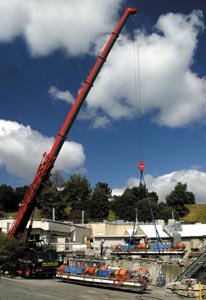
SPEAR revolutionized X-ray analysis just as it revolutionized high-energy physics. For example, to determine atomic structural information using crystallographic techniques, researchers must crystallize the material, record its diffraction pattern and invert that pattern to obtain the real space structure – all tricky endeavours. With the availability of SPEAR and synchrotron radiation, researchers began, for the first time, to use specific wavelengths of synchrotron radiation to directly solve the “phase” part of the experiment (the so-called “phase problem” in crystallography). This new technique, called multiple-wavelength anomalous dispersion phasing (MAD), has proved extremely valuable in solving large numbers of protein molecule structures, and today forms the basis of much of the work done in this field worldwide. X-rays from SPEAR found many other important applications, including solving the mysteries of unusual materials such as the high-temperature superconductors; identifying trace environmental contaminants, such as those found at the Rocky Flats Superfund site; and pinpointing the culprit in the eroding of the Vasa warship, a Swedish national treasure.
On 31 March 2003, the SSRL temporarily shut down as staff began stripping the historic ring of all its innards and replacing them with a third-generation machine that will take synchrotron radiation research to new heights. The upgrade will replace all storage ring magnets, the 235 m long vacuum system, 54 magnet support rafts, the RF system, power supplies, cable plant and floor foundation, and will result in significantly higher photon brightness and more stable photon beams. In the wonderland of science, SPEAR’s smile will linger for years to come – just like that of the Cheshire cat in Alice in Wonderland.







